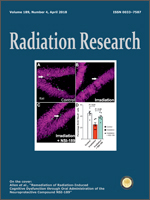In the event of an improvised nuclear device or “dirty bomb” in a highly populated area, potentially hundreds of thousands of people will require screening to ensure that exposed individuals receive appropriate treatment. For this reason, there is a need to develop tools for high-throughput radiation biodosimetry. Gene expression represents an emerging approach to biodosimetry and could potentially provide an estimate of both absorbed dose and individual radiation-induced injury. Since approximately 2–4% of humans are thought to be radiosensitive, and would suffer greater radiological injury at a given dose than members of the general population, it is of interest to explore the potential impact of such sensitivity on the biodosimetric gene expression signatures being developed. In this study, we used wild-type mice and genetically engineered mouse models deficient in two DNA repair pathways that can contribute to radiation sensitivity to estimate the maximum effect of differences in radiosensitivity. We compared gene expression in response to a roughly equitoxic (LD50/30) dose of gamma rays in wild-type C57BL/6 (8 Gy) and DNA double-strand break repair-deficient Atm–/– (4 Gy) and Prkdcscid (3 Gy) mutants of C57BL/6. Overall, 780 genes were significantly differentially expressed in wild-type mice one day postirradiation, 232 in Atm–/– and 269 in Prkdcscid. Upstream regulators including TP53 and NFκB were predicted to be activated by radiation exposure in the wild-type mice, but not in either of the DNA repair-deficient mutant strains. There was also a significant muting of the apparent inflammatory response triggered by radiation in both mutant strains. These differences impacted the ability of gene expression signatures developed in wild-type mice to detect potentially fatal radiation exposure in the DNA repair-deficient mice, with the greatest impact on Atm–/– mice. However, the inclusion of mutant mice in gene selection vastly improved performance of the classifiers.
How to translate text using browser tools
19 January 2018
Global Gene Expression Response in Mouse Models of DNA Repair Deficiency after Gamma Irradiation
Nils Rudqvist,
Evagelia C. Laiakis,
Shanaz A. Ghandhi,
Suresh Kumar,
Jeffrey D. Knotts,
Mashkura Chowdhury,
Albert J. Fornace,
Sally A. Amundson
ACCESS THE FULL ARTICLE

Radiation Research
Vol. 189 • No. 4
April 2018
Vol. 189 • No. 4
April 2018




